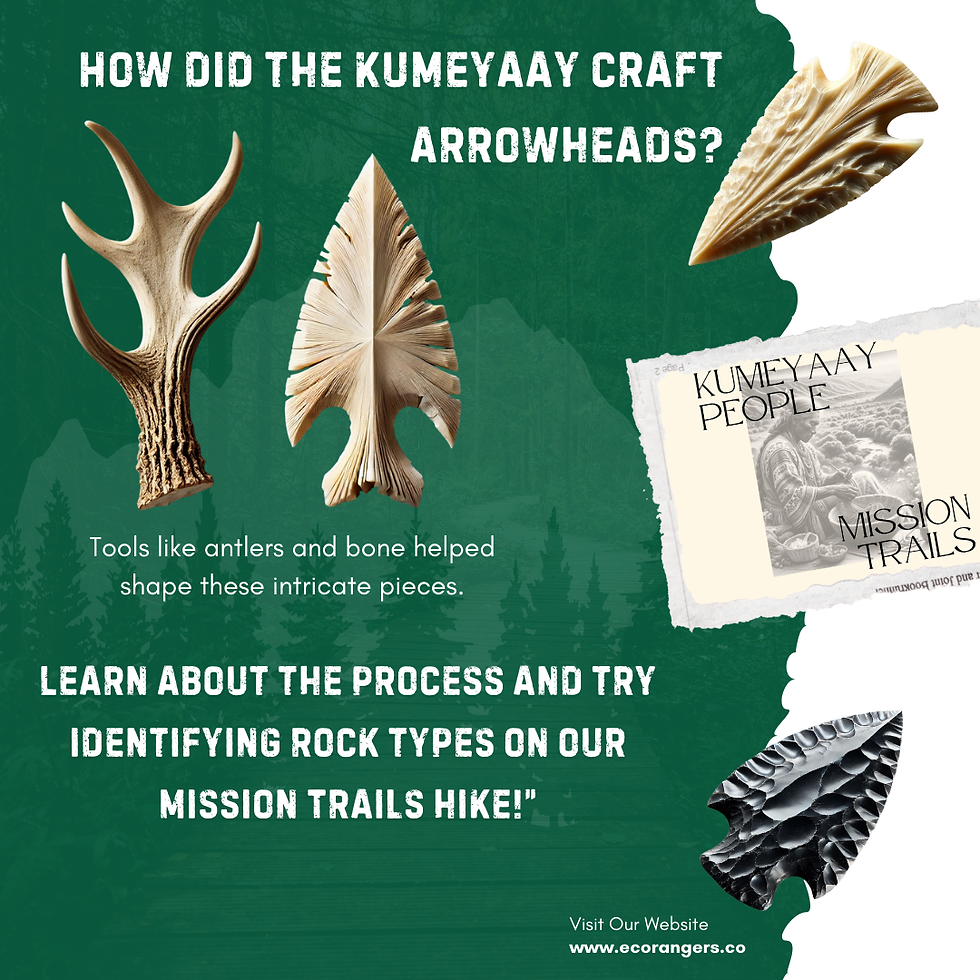From the Past to the Present: What Arrowheads Teach Us
- ecorangers831

- Jan 29
- 3 min read

A Journey Through Time,
Imagine walking through a trail where ancient people once lived, hunted, and thrived. Along the way, you come across a shiny black rock—an arrowhead crafted thousands of years ago. This small artifact carries a big story, connecting us to the Kumeyaay people who once called this land home. They used local materials like obsidian and chert to make tools essential for survival. On this hike, families will not only learn about these incredible tools but also understand why preserving them is vital for protecting history.
Let’s dive into the fascinating world of arrowheads and what they teach us about ancient cultures.

What Arrowheads Teach Us About Ancient Cultures
Arrowheads are like time capsules, revealing the daily lives, skills, and ingenuity of ancient people. Imagine how the Kumeyaay used their surroundings to craft these tools with precision and purpose.
The first lesson arrowheads teach us is how important they were for survival. These small but mighty tools were used to hunt animals for food, clothing, and tools. Think about it—every arrowhead had a purpose. Some were designed to catch small animals like rabbits, while others were crafted for larger game like deer. By studying these artifacts, we can better understand the resourcefulness of the Kumeyaay people.
Next, let’s talk about the materials. The rocks used to make arrowheads, like obsidian and chert, weren’t chosen randomly. Obsidian, for example, is a volcanic rock prized for its sharp edges, while chert is a sedimentary rock that’s more common but still effective. Imagine walking through the landscape and finding the perfect rock to create a tool—it’s like nature providing exactly what was needed.
Arrowheads also tell stories of trade and travel. Did you know that some arrowheads found in San Diego were made from rocks not native to the area? This means ancient people traded materials and traveled long distances. It’s amazing to think about how interconnected communities were even thousands of years ago.
Why We Protect Arrowheads

When we come across an arrowhead on a trail, it’s tempting to pick it up and take it home. But leaving it in place is one of the most important ways we can protect history. Why? Because artifacts like arrowheads are puzzle pieces that help archaeologists understand the bigger picture of how ancient people lived, hunted, and thrived. Moving them disrupts that story and makes it harder for researchers to piece it together.
Preserving arrowheads is also a way of honoring the Kumeyaay people, who have deep cultural ties to this land. By leaving artifacts undisturbed, we show respect for their history and heritage. Plus, arrowheads are part of the natural environment. Removing them can harm the plants, animals, and ecosystems that have grown around them over time.
Tips for Ethical Hiking with Kids
As you hike, teach your kids the importance of being respectful explorers. If they spot an arrowhead, encourage them to admire it without touching. Here are a few tips to make the experience both fun and educational:
Look, Don’t Touch: Take photos instead of picking up artifacts. This keeps history intact for everyone to enjoy.
Stay on Trails: Explain to kids how wandering off paths can harm plants and possibly disturb historical sites.
Be Curious: Bring a journal or sketchpad for kids to draw what they see and write down their observations.
Ask Questions: Get kids thinking: “Who made this? How did they use it? What does it tell us about their lives?”
Report Finds: If you come across a significant artifact, let a park ranger know—it could be an important discovery!
On the Hike: What We’ll Do
During the hike, we’ll turn these lessons into hands-on learning experiences. First, we’ll go on a rock hunt to identify materials like obsidian and chert using a Rock ID app. It’s a fun way for kids to connect geology with history. Next, we’ll demonstrate how ancient people shaped these rocks into arrowheads through a process called flint knapping. Finally, we’ll take time to reflect. Kids can share their favorite discoveries, draw what they’ve seen, or talk about why preserving these treasures is so important.
Fun Activities to Try at Home
Want to keep the learning going? Try these activities with your kids:
DIY Arrowhead Craft: Use modeling clay to create arrowhead shapes and discuss their uses.
Rock Scavenger Hunt: Explore your backyard or a local park to find rocks and imagine what tools they could become.
Storytime: Encourage kids to write or draw a story about someone from ancient times making and using an arrowhead.
Closing Thoughts
Arrowheads aren’t just artifacts; they’re storytellers from the past. By preserving them and teaching kids about their significance, we ensure that future generations can continue to learn from these incredible tools. As you hike through Mission Trails with Eco Rangers, take a moment to appreciate the land, its history, and the people who shaped it. Together, we can honor their legacy and keep these stories alive.


